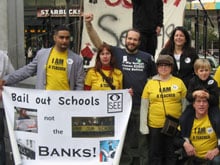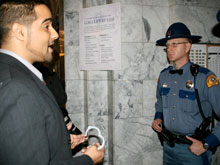
I achieved the greatest moment in my teaching career this past winter.
Though billionaire education reformers may fall out of their brass-studded leather chairs to hear it, I did not attain this moment of euphoria from running bubble tests through a Scantron machine and reading the red-inked percentages it spit out. It occurred, in fact, as hundreds upon hundreds of students streamed past me in the hallways, leaving school in the middle of the day carrying hand-made signs that read, “Fund Our Future!” and “No More Cuts.” I was simply overwhelmed with emotion.
The journey to this pinnacle was a long one—and part of an ongoing struggle—but one worth recounting because I think it offers lessons to educators across the country who face child-abusing budget cuts and teacher-bashing corporate education reform.
I began teaching in an elementary school in Southeast Washington, D.C., in 2001. Directly across from the entrance of the school was a decrepit building with vegetation growing out the windows. The library’s book collection was more appropriate for an archeological study than a source for topical information. Police roamed the halls of our elementary school looking for mouthy kids to jack up against the wall. I had one hole in the middle of the chalkboard and another hole in the ceiling that often meant rain flooded my classroom.
One lasting memory of this experience came on my third day of teaching. I had asked my sixth graders to bring a meaningful object from home for a show-and-tell activity.
We gathered in a circle in the back of the room that Friday morning and the kids sat eagerly with paper bags on their laps that concealed their autobiographical mementos. One after another, each and every hand came out of those crumpled brown lunch sacks clutching a photo of a close family member—usually a dad or an uncle who was either dead or in jail. When it was my turn, all I could do was stare stupidly at the baseball I had pulled out, nervously picking at the red stitches as I mumbled something about how I had played in college.
Only a few days after this lesson, the attacks of 9/11 were carried out, closely followed by the government’s launching of the war on Afghanistan. I received a higher degree in education theory that year as I witnessed our nation spend money to bomb children halfway around the world while refusing to care for my students in the shadow of the White House. Soon, too, it became apparent in all of the No Child Left Behind rhetoric about accountability that I was being asked, from inside of the classroom, to correct all of the mistaken priorities of the politicians.

The Social Equality Educators (SEE) at an Occupy Seattle protest.
Photo by Anna Ludwig
My start in education in Washington, D.C., Public Schools taught me that being a social justice educator has to mean two things: provide an anti-racist curriculum in the classroom and be an activist in the community—that is, fight to restructure society so education is a priority over war spending and bank bailouts.
From this point of view, education reform should have nothing to do with free market “solutions”—schemes such as teacher merit pay, privatized charter schools, or increased worker and student efficiency through standardized tests. Instead, education reform based on social justice should be aimed to provide a holistic education that teaches skills of leadership and social responsibility, and assess students’ abilities to collaborate with peers, reevaluate assumptions based on new evidence, and defend well-reasoned positions on current events—all things impossible to quantify on a standardized test.
My perspective of what it means to be a social justice educator has put me in face-to-face opposition against some of the most powerful people in the education establishment. These people tend to believe that when it comes to assessing outcomes of student success, considering any factors outside of the school-building environment is tantamount to making excuses—perhaps even “socialistic.” To say the least, I make them uneasy.
When U.S. Secretary of Education Arne Duncan came to a Seattle-area high school in July 2010, I had an opportunity to debate him on his advocacy for teacher “merit pay.” When filmmaker David Guggenheim held a special screening of Waiting for Superman in Seattle, I got on the invite list. When the film was over, I gave him “two thumbs down,” and rigorous debate about charter schools. Recently, I joined the Occupy Education “policy throwdown” with the Gates Foundation and confronted the Foundation’s PR spokesperson on its advocacy of using standardized testing in teacher evaluations.

Seattle teacher Jesse Hagopian issuing a citizens arrest to the Washington State House Ways and Means Committee.
Photo by Anna Ludwig
These confrontations uncovered more awareness about corporate-driven education reform and helped win over more educators to the mission of the Social Equality Educators (SEE), an organization that I’m part of.
When Washington state announced that it would hold a special legislative session to decide how to further slash the education and healthcare budgets, SEE headed to Olympia to issue citizen’s arrest warrants to legislators for failing to adhere to the Washington State Constitution that declares education is the state’s “Paramount Duty.” In the course of delivering arrest warrants to the House Ways and Means Committee I was arrested.
While I was in jail, unbeknownst to me, my students at Garfield High School set up a Facebook page titled “Free Mr. Hagopian.” Hundreds of student Bulldogs joined the page in my support. When I was released that night and appeared for school the next day, the students changed the Facebook page to “Seattle Student Walkout for Education.” I have often hoped that my students would one day learn the lessons of history I had taught them—from the struggles of the abolitionists and women’s rights advocates in antebellum America, to student movements against the Vietnam War, to the Freedom Riders of the Civil Rights Movement—and use them to start their own revolution.
The moment my students lost their contentedness with studying history and started making their own – that was the most gratifying day of my career.
Epilogue: Only weeks after the student mass walkout, the Washington State Supreme Court ruled that the State Legislature was in violation of the Constitution and would need to increase funding to education.

Jesse Hagopian is a public high school teacher in Seattle and a founding member Social Equality Educators (SEE). He serves on the Board of Directors of Maha-Lilo—“Many Hands, Light Load”—a Haiti solidarity organization. Hagopian is a contributing author to the book, Education and Capitalism: Struggles for Learning and Liberation (Haymarket Books). He can be reached at: [email protected]
